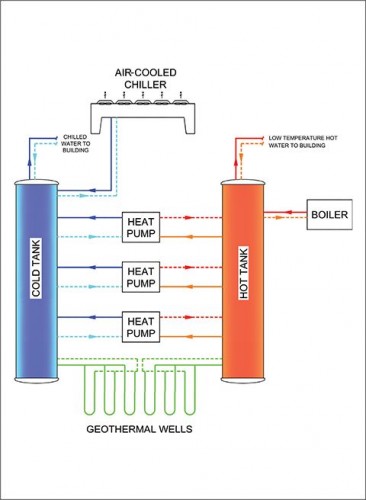Exploring John Abbott College’s latest building

Sustainability
During the construction of the building, more than 75 per cent of the waste generated was diverted from landfill sites. Also, construction materials contained an average of 15 per cent of recycled content and, as mentioned, the Gingko tree remains.
To complete the ‘cycle of sustainability,’ an interactive screen has been installed in the main lobby to explain the sustainable features of the building to students and visitors. Real-time building data and energy consumption are shown on the screen. This building is also part of an engineering course (due next semester) at the college in which the students will have to take real measurements on the building’s different HVAC systems to test their knowledge of the actual systems. Scale mockup air and hydronic systems are also being prepared for use as teaching setups to simulate the components of the building.
The total construction cost of the project is around $35 million—nearly a third of which is dedicated to electromechanical services. In this amount, roughly $1.1 million is specifically associated with energy efficiency. The return for these elements is estimated at less than eight years (further reduced to six years when considering utility grants).
With its many sustainable features incorporated into the integrated design process, this building was able to achieve Gold under the Canada Green Building Council (CaGBC) Leadership in Energy and Environmental Design−New Construction (LEED−NC) program earlier this year. It was also awarded first place in the New Building category at the Association Québécoise pour la maîtrise de l’énergie’s (AQME’s) 2014 Energia Awards, and First Place at the 2014 Contech Awards for Innovative Practices. It is currently being presented in the American Society of Heating, Refrigerating, and Air-conditioning Engineers’ (ASHRAE’s) Technology Awards contest where the project is being judged as finalist at the international level.
Conclusion
John Abbott College’s Anne-Marie Edward Science and Heath Technologies building is an example of sustainable practice through the integrative design process, diligent site management, great education opportunity, energy efficiency, and water use reduction. It demonstrates that by starting at the ‘root’ of a project and developing it upward with a great vision and a common goal, the results can often exceed expectations.
 Pierre-Luc Baril, Eng., HFDP, LEED AP, is an associate at Pageau Morel et associés inc. in Montréal and is specialized in designing energy-efficient laboratories. He is certified as a healthcare facility design professional (HFDP) by the American Society of Heating, Refrigerating, and Air-conditioning Engineers (ASHRAE). Baril is actively involved in the executive committee of CSC’s Montréal Chapter. He can be contacted at plbaril@pageaumorel.com.
Pierre-Luc Baril, Eng., HFDP, LEED AP, is an associate at Pageau Morel et associés inc. in Montréal and is specialized in designing energy-efficient laboratories. He is certified as a healthcare facility design professional (HFDP) by the American Society of Heating, Refrigerating, and Air-conditioning Engineers (ASHRAE). Baril is actively involved in the executive committee of CSC’s Montréal Chapter. He can be contacted at plbaril@pageaumorel.com.
 Nicolas Lemire, Eng., M.A.Sc. LEED AP, is president and principal at Pageau Morel et associés inc. in Montréal. He has more than 17 years of experience in consulting engineering. Lemire is certified as an HFDP by ASHRAE. He can be reached at nlemire@pageaumorel.com.
Nicolas Lemire, Eng., M.A.Sc. LEED AP, is president and principal at Pageau Morel et associés inc. in Montréal. He has more than 17 years of experience in consulting engineering. Lemire is certified as an HFDP by ASHRAE. He can be reached at nlemire@pageaumorel.com.







